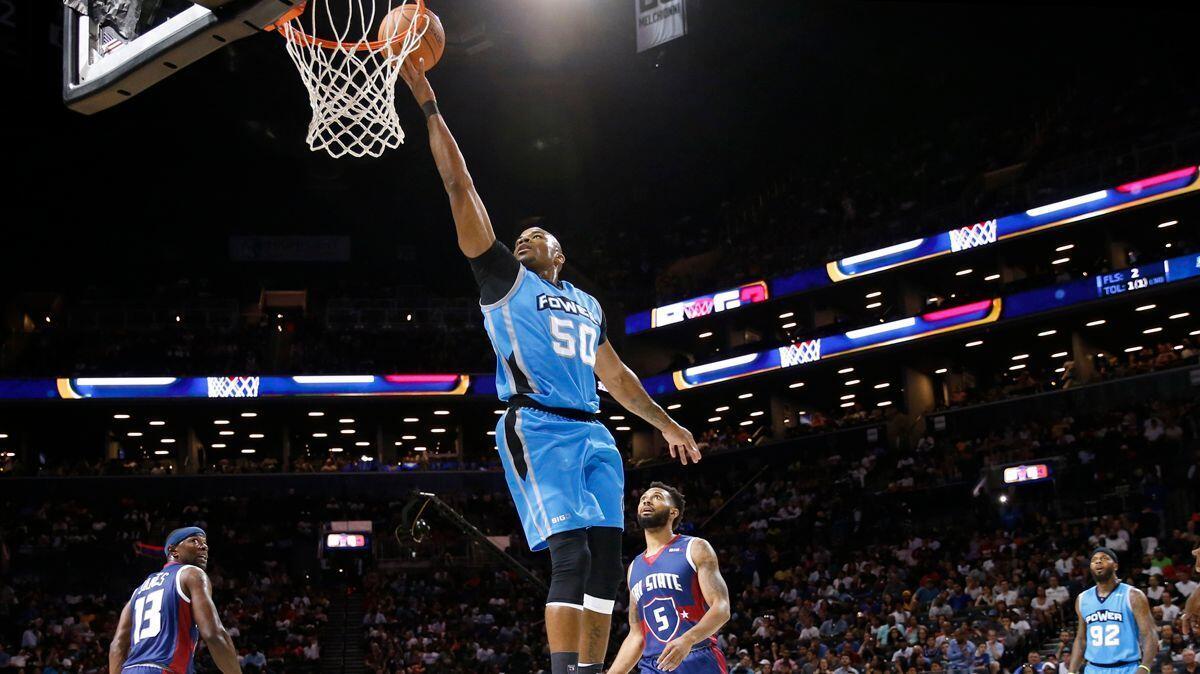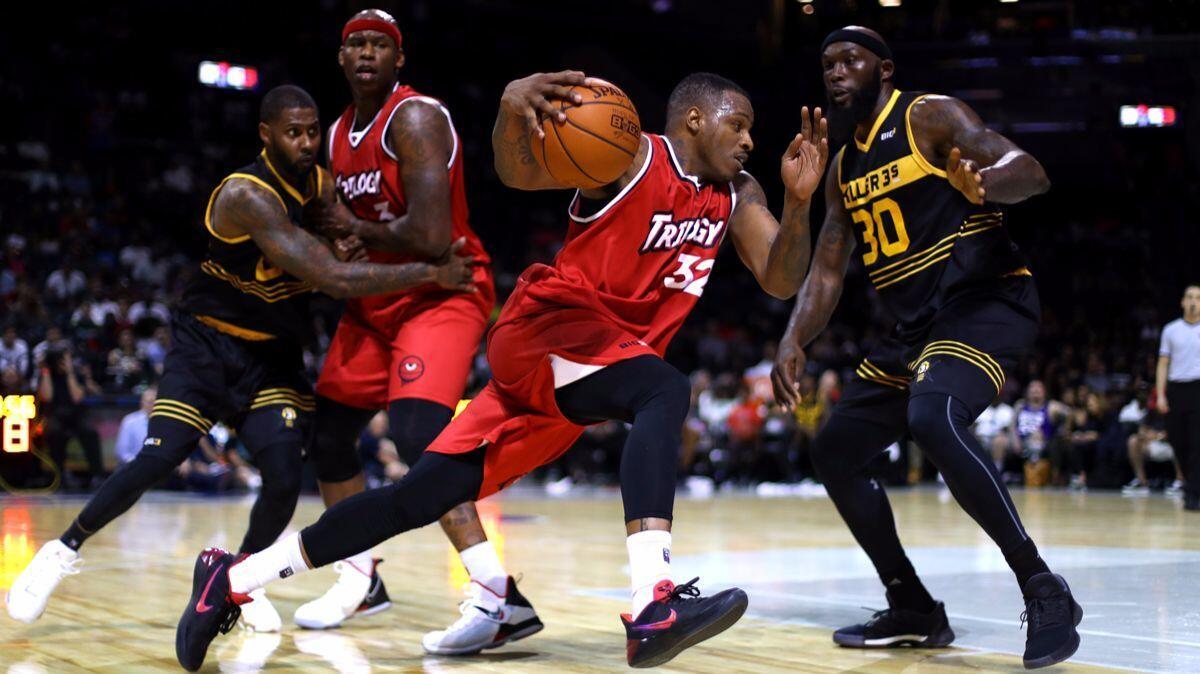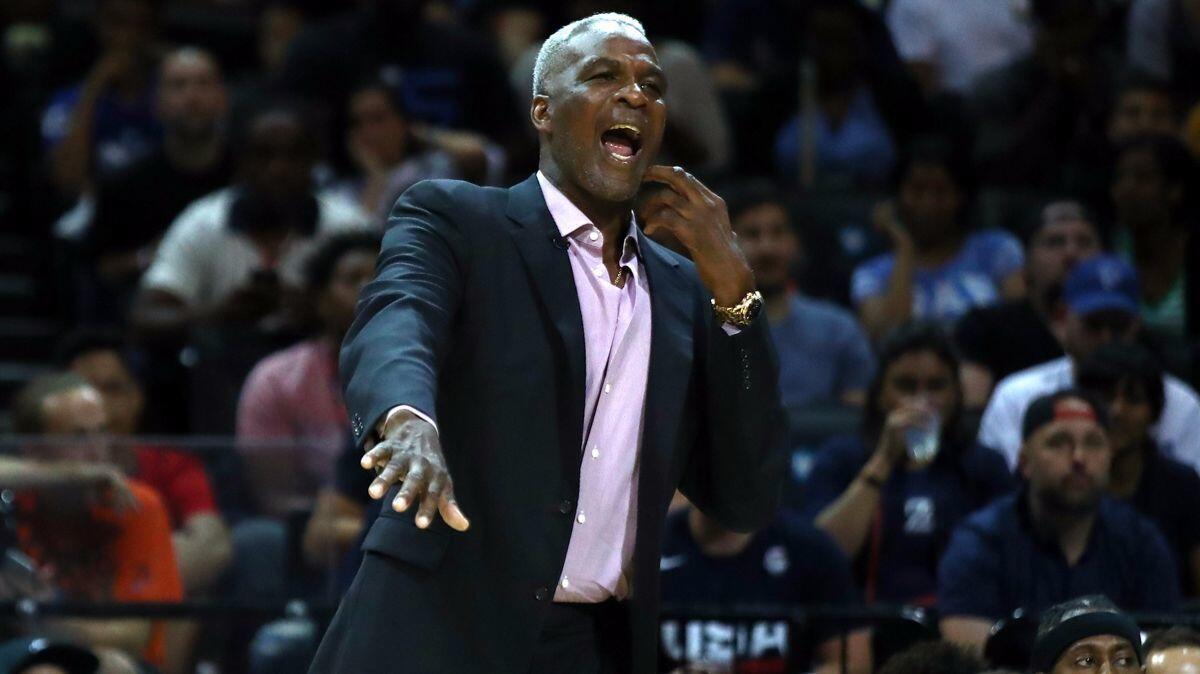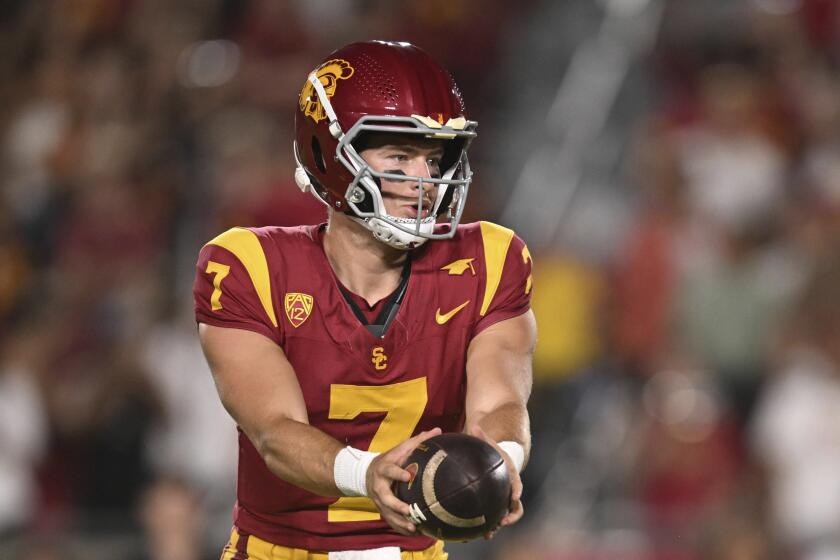The Big3 league is off to hot start and organizers plan to keep up momentum

It was the type of question that launches a sports bar argument: If you could put together the best three-on-three basketball team in the world, who would you call?
As it happened, it was posed to someone with expert insight.
“Man, I might try to get KG [Kevin Garnett], Kobe,” said Paul Pierce, a retired 10-time NBA all-star. “Maybe we set up our own team coming this next year.”
Pierce was speaking during the inaugural games of the Big3 basketball league, a three-on-three venture co-founded by the rapper Ice Cube.
Kobe Bryant is unlikely to join, but the league arrives at a time when three-on-three — long the realm of NBA practices, the courts at Venice Beach and that one guy at the playground who wears work boots instead of basketball shoes — is having a moment. It was recently announced as having a place in the next Summer Olympics.
Part of the sport’s appeal is that it captures the imagination. To follow sports is to debate sports. Would LeBron James beat Michael Jordan in one-on-one? What would the most-super NBA super team look like? Three-on-three, with its compact games and mix of former stars and amateurs, provides a laboratory.
Organizers are trying to convert the momentum into long-term viability. The Big3, which has a stop at Staples Center on Aug. 13, is an eight-team league with a 10-week schedule. It was a surprising success in its first day of games, on Sunday.
About 15,000 fans showed up at the Barclays Center in Brooklyn, roughly the same as a regular-season Brooklyn Nets game. Despite an anachronistic one-day tape delay for television, nearly 400,000 viewers tuned in to Fox Sports 1, which is more than for the the Pac-12 Conference championship game on the same network two season ago.
Attendance and viewership “both exceeded expectations by a lot,” said Jeff Kwatinetz, who co-founded the league with Cube.
Newfound relevance has come after about a decade of work by FIBA, basketball’s international federation. FIBA now runs a World Tour and a World Cup.
Three-on-three was nearly part of the 2016 Summer Olympics in Rio de Janeiro, according to Jim Tooley, the chief executive of USA Basketball and a member of FIBA’s central board. But the IOC hesitated to add to Rio’s construction and budget issues.
FIBA and the IOC haven’t determined who will be eligible when the sport debuts in Tokyo in 2020. But there has already been plenty of speculation about whether NBA players will be allowed, and whether they would want to play. FIBA allows professionals to play in the annual World Cup.
Patrick Baumann, the FIBA secretary general, said in an email that the “goal is to have the best 3x3 players possible at the Tokyo 2020 Olympic Games.”
The game requires a different skill set than five-on-five, though it suits a player like Stephen Curry — quick and a strong defender, with wizardly three-point ability.
James, physically dominant but with an average three-point shot, said he wouldn’t participate in 2020. “I’m not very good in a 3-on-3 thing,” he told reporters during the NBA Finals. “I’m more of a 5-on-5 guy.”

Baumann, for one, wasn’t buying James’ self evaluation.
“I’m sorry but I would have to disagree with LeBron James,” he said. “With a good dedicated 3x3 preparation, he has all the qualities to be a pretty special 3x3 player.”
The world’s top-ranked team is comprised of four Serbs who stand between 6 feet 3 and 6-7. None played in the top traditional leagues in Europe. All earn enough from the sport to play full-time.
FIBA’s rules might be compared to those of traditional basketball, laced with caffeine pills. Instead of two- and three-pointers, there are ones and twos, making outside shooters extra valuable. Games are to 21 points or 10 minutes, with a 12-second shot clock.
The speed of the game breeds upsets: Team USA has won the women’s World Cup twice since its inception in 2012, but the men have been shut out. Serbia has won three World Cups.
The Big3’s games aren’t FIBA speed, and should be familiar to American basketball fans. Most jarring is the addition of four-point circles farther outside the arc and games played to 50 — adjusted down from 60 after the first week’s games went long. Because it is played on a half-court, older, slower players avoid getting scorched in transition.
That allowed the league to enlist retired stars such as Allen Iverson, who is a player and coach. The league drew in him and others with a forgiving schedule and revenue sharing. Players receive 52% of revenue, according to Kwatinetz, and earnings are divvied up according to the standings. For example, seventh place receives double what eighth place gets, Kwatinetz said.
The compensation structure yielded intense, physical contests when the league debuted. Two players, Jason Williams and Corey Maggette, suffered season-ending injuries.
The Big3’s most significant test will be whether it can continue to grow after a strong start. Already, some fans took to social media to complain about the tape delay for television.
“We’re trying to walk before we run,” Kwatinetz said. “We’re doing something really innovative, really unique, and we’re not going to assume that we’re going to do everything perfect out of the gate.”
The championship game, he noted, will be televised live.
We’re doing something really innovative, really unique, and we’re not going to assume that we’re going to do everything perfect out of the gate.
— Jeff Kwatinetz, co-founder of the Big3 league

Failed upstart leagues litter the American sports landscape. The Big3 is unlikely to eclipse the NBA, but it shouldn’t need to. Kwatinetz said the Big3 competes more with baseball than with the NBA.
The game “fits in nicely with the instant gratification generation,” said Tooley, of USA Basketball.
And it’s played during the summer months, a sports span that “is boring as ...,” Cube noted at a news conference early this year.
Andre Owens, a journeyman who has played in the NBA and in Europe and was drafted onto Iverson’s team, said the game, played in close quarters, is more likely to turn personal.
He said a good basketball player is a good basketball player, regardless of the rules. Owens’ ideal three would include Shaquille O’Neal “because he’s the most dominant big man to ever play the game, so we’d just throw it right down to Shaq,” and Bryant because his one-on-one skills are legendary and he has three-point range.
The third?
“Me,” Owens said. “I’m just a flat-out good player.”
Sounds like the start of a good debate.
Big3 league schedule:
Sunday: Charlotte, N.C.
July 9: Tulsa, Okla.
July 16: Philadelphia
July 23: Chicago
July 30: Dallas
Aug. 6: Lexington, Ky.
Aug. 13: Los Angeles (Staples Center)
Aug. 20: Playoffs, Seattle
Aug. 26: Championship, Las Vegas
Follow Zach Helfand on Twitter @zhelfand
More to Read
Get our high school sports newsletter
Prep Rally is devoted to the SoCal high school sports experience, bringing you scores, stories and a behind-the-scenes look at what makes prep sports so popular.
You may occasionally receive promotional content from the Los Angeles Times.







